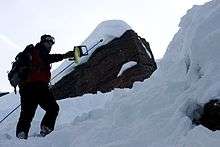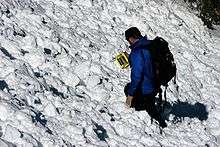RECCO
The Recco system is an electronic method of finding a person or persons buried in snow as a result of an avalanche.

History
The Recco system was developed in response to an avalanche tragedy that involved the inventor, Magnus Granhed, in Åre, Sweden, in 1973.
Magnus collaborated with researchers at the Royal Institute of Technology in Stockholm, at first studying all the existing technologies. Although active avalanche transceiver were found to be most effective, but transceivers had disadvantages of high cost, the need to turn them on and off, and a requirement for batteries. This led Magnus to look at a passive reflector that could be carried by a skier all times and would be a simple and practical solution.
In 1975 John Lawton, the developer of the Skadi avalanche transceiver, proposed that a reflector could be put on a lift ticket. During the northern-hemisphere winter of 1978/1979 Magnus worked in conjunction with the Royal Institute of Technology in Stockholm, painstakingly conducting an experiment to measuring radio frequency penetration of snow. All winter, radio waves were sent into the snow, and by varying the frequencies every few hours an optimum frequency for penetration of the snowpack was arrived at.
Magnus formed Recco AB in 1980 and soon created a first prototype; while it was heavy and cumbersome, it worked.
As of 2009 the active part of Recco system now utilizes a small hand-held detector, which can easily be carried by one rescuer travelling on foot or from in a helicopter. These detectors are now standard equipment with more than 700 ski resorts, mountain rescue teams, and parks worldwide.[1]
How it works

The Recco system consists of two parts: a reflector integrated into clothing, boots, helmets, and body protection worn by skiers and riders; and a detector used by organized rescue teams.
The reflector consists of a small, flat capsule, about 1/2" by 2" by 1/16" thick (13 mm × 51 mm × 1.5 mm), which contains a pair of foil aerials, joined by a diode. The size of the aerials makes the unit a tuned circuit resonating at one specific frequency. The reflector is passive meaning it has no batteries and it never has to be switched on. Recco recommends users be equipped with two reflectors placed on opposite sides of the body. Many garment manufacturers now place one in one jacket sleeve and one in the opposing side trouser leg. Many snowboard and ski boot manufacturers place one in each boot.
The detector sends out a highly directional signal on that frequency from an area projecting from the front of the unit, and if the signal ‘hits’ a reflector it is bounced back. And, due to the diode the returned signal is doubled in frequency - harmonic radar.[2] Thus the detector tells the operator that it is pointing at a reflector, and not just a piece of metal the right 'length'.
The returned signal is translated into an audio tone whose volume is proportional to the returned signal, and by means of a volume control a trained rescue operator can literally go straight to the buried reflector once a signal is detected.

Recco's newest detector - 9th generation released in 2009 - also includes an avalanche rescue beacon receiver. The R9 detector allows a single rescuer to perform both the search for Recco reflectors and 457 kHz avalanche beacons at the same time.
The Recco signal easily passes through air, dry snow and ice. Liquid water absorbs the signal, so in spring time when the snow is wet—liquid water present—the range is decreased. Rescuers need to make slight adjustments to their search tactics when searching in wet snow conditions.
The Recco system transmits on 917 MHz[3] at around 1.5 watt and uses the tuned dipole diode transponder to double this signal to 1834 MHz. It is this 1834 MHz return that is used by the Recco receiver in the search unit. The transponders are not that precise and a signal a few MHz higher or lower will also be doubled, thus a signal at 915 MHz will yield a return at 1830 MHz. As the frequency range of the Recco device falls fully within the Amateur Radio 900 MHz band this opens up an opportunity to experiment. And due to the somewhat broad nature of the Recco transponders it is possible to transmit far enough away from the target frequency that there would not be an issue, indeed the Recco unit is totally unaffected by a signal at 915 MHz.
Usage
The search with the Recco detector is very similar to how an avalanche rescue beacon search is performed. The avalanche debris area is searched in 20m wide corridors. The detector can be used by a rescuer on foot, skis, or from a helicopter who aims the detector toward the snow. Once a signal is heard the operator orients the detector to the strongest signal and follows the tone—along a straight line. When the tone disappears the rescuer is right above the victim. The detector is then aimed downwards at the snow and several rapid crisscross sweeps are done to pinpoint the signal. Unlike an avalanche beacon the Recco detector is truly directional and accurately pinpoints the location. A probe pole is recommended to determine the burial depth.
The time to search with the Recco detector is about the same as the search time with a transceiver so large areas can be searched very quickly.
Capabilities
The Recco system is not intended for companion rescue and is not a substitute to transceiver use in the backcountry. The Recco detector is another tool for organized rescue teams that complements their other search methods including rescue dogs, transceiver, and probe lines.
The system was originally developed for use at ski resorts where it is already recognized to be extremely valuable for ski-resort-based rescue teams and ski patrols. However, its value is not confined only to ski resorts. Even in the backcountry, Recco has demonstrated its capability to find buried victims quickly.
Time is the enemy of all buried avalanche victims, and devices and technologies that can significantly reduce search times can make a difference for buried victims. Transceivers, Recco, and dogs are all much faster than probe lines.
In 2015 RECCO AB introduced the SAR-1[4] helicopter detector that expands the use of RECCO technology from avalanches to finding missing people in mountains, forest, and water.
The June 2016 issue[5] of the Journal of Wilderness and Environmental Medicine presents the case report of a live rescue of a buried off-piste skier using Recco equipment that occurred in Spain 2015.
References
- ↑ http://www.recco.com/resorts-operations
- ↑ Rasilainen, Kimmo; Viikari, Ville (2015). "Transponder Designs for Harmonic Radar Applications". International Journal of Antennas and Propagation. 2015. doi:10.1155/2015/565734. Retrieved 8 June 2016.
- ↑ Hereford, John; Edgerly, Bruce (October 2000). "457 KHz Electromagnetism and the Futre of Avalanche Transceivers" (PDF). Proceedings of the ISSW 2000, Big Sky, MT, USA: 352.
- ↑ Weiss, CC. "RECCO streamlines helicopter search and rescue". www.gizmag.com. Retrieved 5 August 2015.
- ↑ Grasegger, Katharina; Stapazzon, Giacomo; Procter, Emily; Brugger, Hermann; Soteras, Inigo (June 2016). "Avalanche Survival After Rescue With the RECCO Rescue System: A Case Report". Wilderness and Environmental Medicine. 27 (2): 282–286. doi:10.1016/j.wem.2016.02.004.